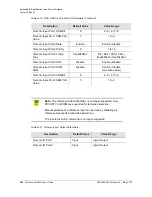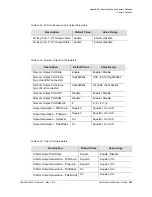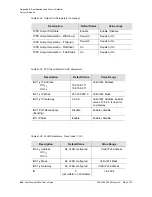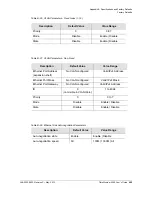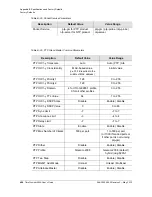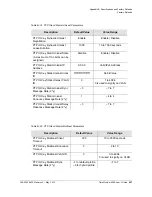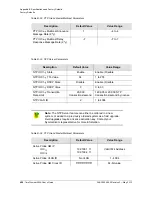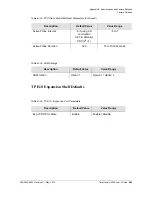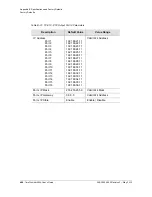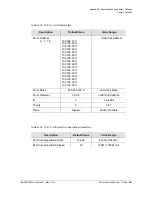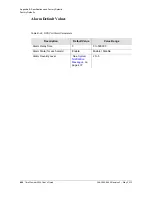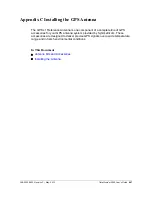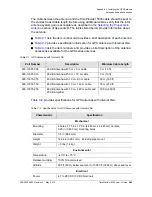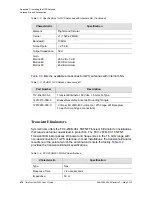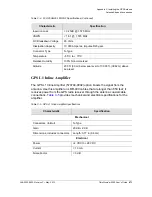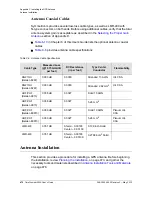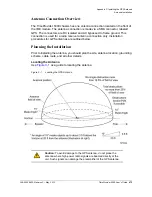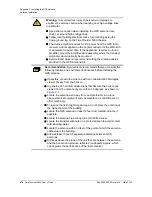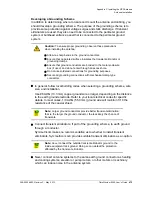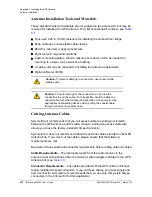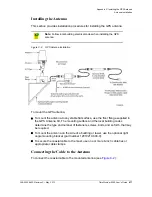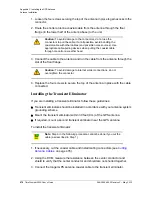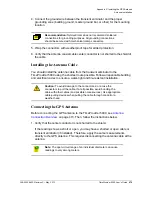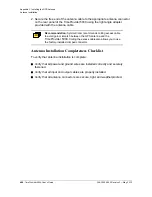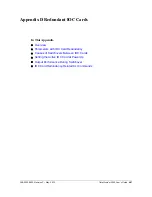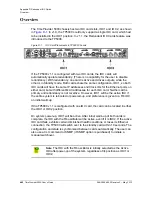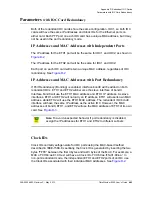
468 TimeProvider 5000 User’s Guide
098-00028-000 Revision F – May, 2012
Appendix C Installing the GPS Antenna
Antenna Kits and Accessories
Antenna Kits and Accessories
This section provides a list of antenna kits and accessories as well as descriptions
and associated part numbers.
To order any accessory, contact the Symmetricom Sales Department. See
http://www.symmetricom.com/company/contact-information/sales-offices
for sales
support contact information.
Selecting the Proper Gain Antenna
When installing the GPS radio receiver, it is important to select the proper gain
antenna and coaxial cable that accounts for the insertion loss between the antenna
and the radio receiver to avoid under-driving or over-driving the radio receiver
antenna input. The gain required at 1575 MHz for a GPS radio receiver input is the
manufacturer’s specification for the radio receiver to acquire satellites, with some
level of signal degradation allowed.
L1 Antenna gains are usually specified as the minimum effective gain. Such
antenna gains can have 4.5 to 10 dB more signal strength at different satellite
azimuths and elevations, depending on their reception pattern. The GPS engine
requires a net gain at the antenna connector input of the chassis (GPS or GNSS
port) to be between
25 dB and 35 dB. This tolerance allows for the signal loss of the
internal and external coaxial cable and connectors. The optimal gain at the GPS
radio receiver input is 30 dB. The total gain is the gain of the GPS antenna less the
loss of the transient eliminator, connectors, and cables.
All antenna kits include the GPS L1 antenna, mounting pipe, floor flange, transient
eliminator, pre-assembled coaxial cable (for antenna to transient eliminator), roll of
3M 2150 weatherproof tape, and a right angle adapter. The antennas, transient
eliminators, and in-line amplifiers have N-type connectors.
All antenna kits supplied use LMR-400, or equivalent, low-loss coaxial cable. Other
types of coaxial cable are available for GPS antenna applications; however, it is
imperative that you calculate the specific cable loss to ensure a gain between 25 dB
and 35 dB at the antenna connector input. The L1 signal loss of LMR-400 is
0.167 dB/meter. The L1 signal loss of a 90 V transient eliminator is typically
0.25 dB.
GPS Antenna Kits With Low Noise Amplifiers, 26, 40, or 48 dB
Symmetricom offers three versions of GPS antennas with 26, 40, or 48 dB total Low
Noise Amplifier (LNA) gain. These antenna kits, which are compatible with most
commercial GPS receivers, receive, amplify, and filter the L1 (1575.42 MHz) signal
from GPS satellites. The antenna is housed in a weatherproof package suitable for
permanent installation in an exposed location. For additional transient eliminator
protection requirements, you can install a 250B-90 Gas Tube transient eliminator in
series with the antenna coaxial cable.
Содержание TimeProvider 5000
Страница 12: ...Table of Contents 12 TimeProvider 5000 User s Guide 098 00028 000 Revision F May 2012 ...
Страница 16: ...List of Figures 16 TimeProvider 5000 User s Guide 098 00028 000 Revision F May 2012 ...
Страница 20: ...List of Tables 20 TimeProvider 5000 User s Guide 098 00028 000 Revision F May 2012 ...
Страница 56: ...56 TimeProvider 5000 User s Guide 098 00028 000 Revision F May 2012 Chapter 1 Overview Alarms ...
Страница 270: ...270 TimeProvider 5000 User s Guide 098 00028 000 Revision F May 2012 Chapter 3 Simple Network Management Protocol SNMP ...
Страница 370: ...370 TimeProvider 5000 User s Guide 098 00028 000 Revision F May 2012 Chapter 5 Operating Managing PTP Clients ...
Страница 524: ...524 TimeProvider 5000 User s Guide 098 00028 000 Revision F May 2012 Appendix F PTP Probe Option Analyzing Probe Data ...
Страница 534: ...Index W W 534 TimeProvider 5000 User s Guide 098 00028 000 Revision F May 2012 ...

